What’s Up?
Installment 2: Gliese 12 b: The Discovery of a Planet
on his extraordinary adventure that led to the discovery of the new planet Gliese 12 b.
What’s Inside This Issue?
- Concepts and Terminology: Discover concepts and terminology introduced in the featured article.
- Featured Article: Join Shishir Dholakia on his journey of discovering the new planet Gliese 12 b.
- About the Author: Meet our astronomer.
- Hands-On Activities: Engage in fun activities tailored to show you how exoplanets are discovered.
- Equity and Sustainability through Astronomy: Examine how doing some astronomy can contribute to advancing equity and sustainability.
- Glossary: Recap key concepts and terminology from the featured article.
Concepts and Terminology
| Terminology | Definition | Image |
|---|---|---|
| Atmosphere | The layer of gases that surrounds a planet or moon. It’s like a blanket of air protecting the surface from harmful radiation and helping regulate temperature. Earth’s atmosphere is made up mostly of nitrogen and oxygen, with smaller amounts of other gases. Image source: https://www.esa.int/ESA_Multimedia/Images/2019/11/View_of_Earth_s_atmosphere_from_space |  |
| Light Year | A unit of distance used in astronomy because space is so vast. It’s the distance light travels in one year, which is an incredible 9.5 trillion kilometers! It’s not a measure of time, but rather how far light can travel in a year. Image source: https://starchild.gsfc.nasa.gov/docs/StarChild/questions/question19.html | 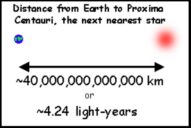 |
| Red Dwarf Star | A small, cool star that burns much fainter than our Sun. These stars are very common in the Milky Way galaxy. Because they are cooler and redder, they wouldn’t appear very bright in the sky if one were close to our solar system. Gliese 12 is a red dwarf star. Image source: Artist’s rendition of Gliese 12 in the background: https://svs.gsfc.nasa.gov/14581/ | 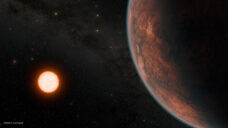 |
| Transiting Exoplanet Survey Satellite (TESS) | A NASA space telescope launched in 2018. Its mission is to search for exoplanets (planets outside our solar system) by looking for them as they pass in front of their host stars, causing a temporary dip in the star’s brightness. TESS is like a giant eye in space, constantly scanning the skies for these tiny dips that reveal hidden worlds. Image source: https://www.nasa.gov/universe/nasas-tess-spacecraft-starts-science-operations | 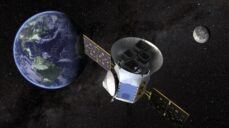 |
| Transit | In astronomy, a transit occurs when one celestial object passes directly in front of another, as seen from our perspective. The most common example is when a planet passes in front of its star, blocking a small portion of the star’s light. This temporary dimming allows scientists to study the planet and estimate its size. Image source: Light curve of a planet transiting its star: https://science.nasa.gov/resource/light-curve-of-a-planet-transiting-its-star/ | 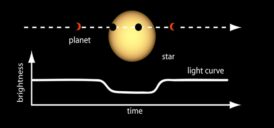 |
Featured Article
Gliese 12 b: The Discovery of a Planet
by Shishir Dholakia
Hey there! My name is Shishir, and I’m hoping to cover something a little more personal this month. My job is to study exoplanets – planets that orbit around stars other than our sun. A few weeks ago, a planet discovery I’ve been working on was finally published in a journal paper! It has been quite a whirlwind, with the discovery being featured by NASA and in several news outlets. In this piece, I’m hoping to share with you all what this discovery was, why I think it’s cool, and how I went about it.
First, let’s set the context. You may know that the Sun has eight planets, including Earth. Scientists have discovered that most stars in the night sky also have their own planets, known as exoplanets. These exoplanets were first discovered only a few decades ago, and our knowledge of them is expanding rapidly. Over 5,000 exoplanets have been confirmed so far, each one unique. While we expected to find planets similar to those in our solar system, none of the discovered exoplanets have matched our expectations.
Image Credit: NASA
The search for exoplanets is driven by a fundamental question: could life exist elsewhere? To answer this, scientists focus on various factors, with the presence of liquid water being a crucial consideration. Liquid water is critical for life because it acts as a universal solvent, dissolving the chemicals necessary for biological reactions and transporting nutrients within organisms. It’s also a building block of life itself.
Understanding an exoplanet’s temperature is paramount in assessing its potential for life. Planets that are too hot lose water to vapor, while those too cold have frozen oceans. Every star has a habitable zone, or “Goldilocks zone,” where orbiting planets receive the right amount of energy for liquid water to exist. However, habitability extends beyond temperature. Planets likely need an atmosphere to support life, providing breathable air and shielding from the harshness of space. Therefore, in the search for potentially habitable exoplanets, scientists not only look for planets within the habitable zone but also investigate their atmospheres to assess their potential to support life.
Image Credit: NASA
About a year ago, I was looking through some data from NASA’s Transiting Exoplanet Survey Satellite (TESS) and I found something really cool: a few slight blips in the brightness of a star. These blips were caused by transits, which occur when a small amount of light is blocked as a planet passes in front of its host star. A majority of those 5000 exoplanets have already been identified. Immediately, I realized this one would be special because according to my calculations, the amount of light blocked meant that this planet was Earth-sized.
Further analysis revealed the orbital period, or the time it takes for this planet to orbit its star, was around 12 days. The star was a cool red dwarf, so this meant that this planet might have the right temperature for liquid water. What’s even more intriguing, this planet was only 40 light years away – one of the closest transiting planets ever found. If real, then it would be a very special discovery! I, along with other members of my group, immediately put together a plan to follow this planet up with telescopes all over the world. We called the new planet Gliese 12 b, named after the star that it orbits called Gliese 12.
Soon, I found myself leading a large group of astronomers to chase down more transits of Gliese 12 b. With each successive transit, we refined our calculations. We chased down other kinds of data to confirm that Gliese 12 b is a real planet and not a false positive. Soon, we were confident we were looking at an exciting Earth-sized planet. We wrote up the discovery into a scientific paper and submitted it to a journal.1
Artist’s rendition of what Gliese 12 b could look like. Image Credit: NASA/JPL-Caltech/R. Hurt (Caltech-IPAC)
So far, the biggest hype in the search for potentially habitable planets has been that around red dwarf stars. These stars are the most common in the galaxy. If planets around them can be habitable, it would make sense that life is common in our galaxy. We also know that the rocky planets orbiting around these stars are common. On the flip side, it is thought that these stars are very active when young and blast away the atmospheres of any planets revolving around them.
So, it was particularly interesting that this star (Gliese 12) showed almost no activity. That also makes it an exciting target to search for signs of an atmosphere with the James Webb Space Telescope and the Hubble Space Telescope. With these telescopes, we believe we can peer deep into this particular star system and study not only whether an atmosphere exists, but also its chemical composition. This could provide insights into the types of atmospheres of planets within this important temperature range.
Overall size comparison of Webb [to the left] and Hubble [to the right], Image Credit: NASA
Understanding planetary atmospheres is crucial, as our own solar system demonstrates. In our solar system, Venus is commonly called Earth’s twin planet. They’re about the same size and weight, and they receive similar amounts of light from the Sun. Perhaps it’s more accurate, though, to call Venus an evil twin of the Earth. Its surface temperature is a whopping 870 degrees Fahrenheit, hot enough to melt lead. Venus is even hotter than Mercury, despite receiving less light from the Sun because it’s farther from the Sun. Though superficially similar to the haven for life that is Earth, a more careful look reveals that Venus could not be more different.
Image Credit: NASA: Venus, Earth and Its Moon, and Mars
The distinction boils down to (pun intended) the atmospheres of the planets. Venus’s atmosphere traps so much light and heat that it’s hotter than even Mercury, a planet that receives much more light from the Sun. By contrast, Earth’s atmosphere traps just enough heat to make the Earth habitable. We think that at some point in the history of Venus, there was a runaway greenhouse effect caused by a growing amount of carbon dioxide in the atmosphere. As the atmosphere began to trap more heat, the oceans evaporated, trapping even more heat by cloud cover. The Earth is just beginning to experience a similar greenhouse effect now, due to humans pumping carbon dioxide into the atmosphere at unprecedented levels.
Image Credit: NASA’s Goddard Space Flight Center/Mary Pat Hrybyk-Keith
Gliese 12 b receives in between the amount of light from its star as Earth and Venus do. Its predicted surface temperature is a balmy 100 degrees Fahrenheit, but this could be significantly higher or lower depending on its atmosphere. This is why Gliese 12 b is a perfect exoplanet to study: to help us learn more about why Venus and Earth turned out so differently in our solar system. By studying its atmosphere, we can learn whether it is more like Earth, more like Venus, or entirely different. In addition to being important for the search of habitable conditions, this planet could tell us more about how the greenhouse effect changes habitability on planets.
An artist’s impression of different kinds of atmospheres on Gliese
12 b, with the Earth for comparison. Shown on the right side, Gliese 12 b could have no atmosphere (left), a thin atmosphere like the Earth (middle), or a thick one like Venus (right). Image Credit: NASA/JPL-Caltech/R. Hurt (Caltech-IPAC)
It has been quite a privilege to discover and study Gliese 12 b, but this is just a start. Personally, this finding has been incredibly rewarding and has fueled my passion for a career in STEM. I hope you’ll consider pursuing one, too! I’m very excited to study the atmosphere of Gliese 12 b in the near future, and I have no doubt this planet will be analyzed in depth by scientists globally in the coming years. Stay tuned for more information as we learn about it!
Reference:
- Dholakia, S., Palethorpe, L., Venner, A., Mortier, A., Wilson, T., Huang, C., Rice, K., Van Eylen, V., Nabbie, E., Cloutier, R., Boschin, W., Ciardi, D., Delrez, L., Dransfield, G., Ducrot, E., Essack, Z., Everett, M., Gillon, M., Hooton, M., … Wright, D. (2024). Gliese 12 b, a temperate Earth-sized planet at 12 parsecs discovered with TESS and CHEOPS, Monthly Notices of the Royal Astronomical Society, 531 (1),1276–1293. https://doi.org/10.1093/mnras/stae1152
About the Author
Hello! My name is Shishir, and I am excited to share the wonders of the universe with you in the section “What’s up.” I first met Paul at the Santa Clara county Science Fair when I was in middle school, where we bonded over our shared love of science and technology. I completed my bachelor’s degree in Astrophysics at the University of California, Berkeley, where I even took a class with Paul! I am now a PhD researcher at the University of Southern Queensland in Australia trying to learn more about exoplanets – planets around stars other than our Sun. Although my job has now advanced beyond stargazing, I’m still passionate about going out on a dark night and looking up at the beautiful night sky. Often, I’ll bring a telescope and a camera to enjoy even better views and take photographs of distant nebulae and galaxies. I’m pretty familiar with all the stars in the Northern Hemisphere now, even the ones at 5 AM. When I got here it was a little eerie, because I couldn’t even recognize half the sky, and the side that I could recognize was upside down. It’s very strange to see Orion and even the moon upside down. In my free time, I also enjoy playing badminton and taking photographs of nature.
Hands-on Activities
Exoplanet Transit Simulations
These two hands-on activities are fun and should take relatively little time. In them, you will imitate planetary transits and learn their tell-tale signs. Activity One is a physical experiment and Activity Two is a computer simulation.
In both, you’ll be making “light curves.” These curves are plots of an object’s light intensity versus time. Light intensity values are plotted on the y-axis, and time on the x-axis. What look like solid curves are usually made up of many data points. In astronomy, there could be many different reasons why an object dims and brightens, [1] but the way in which the light intensity drops down and rises again for a planetary transit has a characteristic shape telling you, “Hey! This is a planet!”
ACTIVITY ONE
A transit is an eclipse. You’ll make a model eclipse and discover the signature shape of the light curve during a planetary transit. You’ll use a light meter, which is a tool for measuring light intensity. It gives you an exact answer – a number – to the question, “How bright is that light right now?” [2] The unit of measure of light intensity in this example is a “lux.”[3]
No light meter? Don’t worry; getting one may only be a few clicks away. If you have access to a smart phone, you can consider downloading a light meter application. Smart phones have at least one physical built-in light meter to help set the screen brightness. Clever people have learned how to access the meter and have written phone apps that take advantage of it. For this activity, we chose the free “Lux Meter” app for an Android™ phone.[4], [5]
Here’s what to do. One person can do it alone, but two or more people working together will make it easier and more fun. Take turns to:
Step 1: Download and start up the application. Make sure that you can see the chart. (If your app only has a meter and not a chart, you’ll need to record the light intensity and times in some way.)
Step 2: Find a lamp near you, then orient the phone to get the highest reading in lux. Hold that orientation steady and bring the phone close enough to the lamp so that the intensity shows on the chart. You’re trying to reach a light value about half-way up your chart, if possible, so that you can see changes more easily.
Step 3: When we aimed our phone (our ‘light meter’) directly at the lampshade (our ‘star’), we got a reading of roughly 80 lux. We then held the light meter in that orientation and position, and we slowly moved an empty paper towel tube (our ‘planet’) from the left to the right, moving the tube between the meter and the lamp while keeping the distance to the lamp roughly constant. It took about 5 to 10 seconds for our ‘transit.’ You can try something other than a tube, anything that resembles a planet in front of your sun. By the time we had recorded intensities for 10 or 20 seconds, we had enough data. We stopped the data collection by tapping on the pause icon. Then, using our fingers on the screen, we adjusted the plot up/down/left/right and scaled it. We got a screenshot by pressing the volume-down and power buttons simultaneously to get a picture like the one you see below.
Screenshot taken from the Android™ application “Lux Meter.”
The chart shows us what the transit looks like. The light was at some higher level (about 80 lux), then it began to drop evenly with time (‘linearly’) as the eclipse started, next dipping to some lower level (about 30 lux) for a short time while the transit occurred. Then, the light level went back up linearly again as the transit completed, similarly to the way it dropped, only in reverse, back to the original value. The curve’s shape resembles a bathtub!
Step 4: Ask yourself these questions, if your planet were different. Can you carry out the experiments?
- What would happen if your ‘planet’ were a bigger version? Would the bathtub get deeper or shallower?
- What would happen if your ‘planet’ is farther from your ‘sun’ and therefore takes longer to pass by? Would the bathtub get wider or narrower?
- What would happen if there were multiple planets, say one closer and one farther away, and you looked over many transits? Would you see many dips? How could you tell which planet would be responsible for which dip in brightness?
ACTIVITY TWO
The second activity builds on what you’ve just learned. Now, you’ll run a free hands-on simulation of a planet passing in front of a star and see how the starlight changes with time.
This simulator was developed at the University of Nebraska-Lincoln.[5] It runs in a browser window, so no download is required. We’ll guide you now, so that you can quickly get results. This is part of a full university course, so we won’t go into anywhere near as much detail here, but try the following settings to simulate a transit.
Settings: Presets: select “Option B” from the pull-down menu and click “set.” This is said to be similar to Earth in its orbit. Increase the radius to 2.00 x Rjup.
You Should See: See the size of the satellite moon increase in front of the star in the drawing on the upper left as you increased the radius. Not sure? Click “set” again and change the radius again. Can you see the shape of the light curve on the upper right? We’ve shown our attempt in the figure below.
The plot axes are the same as in Activity One. Try clicking on “show simulated measurements” and adjust the amount of noise in the measurements. Comparing the simulation results of Activity Two to your prior Activity One results above should build up your confidence. You now know what to look for when searching for exoplanets by this method! Can you see the similarity in the shape of this curve to the curve in Activity One? Does it also look like a bathtub? This would be a great time to go back to the reference in footnote [1] below, to compare the uniqueness of planetary transit light curves to light curves from other astronomical phenomena.
References for the Hand-On Activities
[1] https://en.wikipedia.org/wiki/Light_curve
[2] In a real astronomical observation, the light meter will be at the near end of a telescope, often carried aloft on a satellite. The reason for going into space is to eliminate the fluctuations you see from our Earth’s atmosphere (i.e., get rid of the star’s twinkle).
[3] https://en.wikipedia.org/wiki/Lux
[4] https://www.photoworkout.com/best-light-meter-apps/
[5] https://play.google.com/store/apps/details?id=com.tsang.alan.lightmeter&hl=en_GB&gl=US
[6] https://astro.unl.edu/naap/esp/animations/transitSimulator.html See the “About” tab for more information.
Equity and Sustainability through Astronomy
Astronomy and Environmental Sustainability:
Gazing at the vast expanse of stars has filled humanity with wonder for millennia. This sense of awe can inspire us to protect our own fragile blue marble. The same curiosity that compels us to explore the cosmos can be harnessed to find solutions to the environmental challenges we face right here at home. By understanding Earth’s place in the universe, we can develop a deeper appreciation for its unique ability to sustain life. In essence, protecting our environment becomes a way to safeguard this precious oasis in the vast cosmos.
Astronomy plays a key role in protecting our planet! Satellites orbiting Earth, built with astronomical knowledge, aiming telescopes with sensors back at our Earth, track crucial environmental changes like rising sea levels and shrinking ice caps. This information empowers us to understand the impact of our actions and develop solutions for a sustainable future. By studying the universe, we gain the insights we need to protect our own planet.
Image Credit: Nasa: Blue Marble 2002
Opening up the universe to all!
Astronomy can achieve the goals of inclusion, diversity, and opening up the universe to all in several exciting ways:
- Community outreach programs: Organizations like Astronomers Without Borders and AstroCamp bring astronomy education and stargazing experiences directly to underserved communities.
- Online resources and citizen science projects: Websites like Zooniverse offer free, online astronomy projects where anyone can contribute to real scientific research, regardless of location or background.
- Mentorship programs: Connecting young students with professional astronomers from diverse backgrounds can provide crucial guidance and inspiration. Organizations like the National Society of Black Physicists and the American Astronomical Society’s Committee on the Status of Minorities in Astronomy facilitate such connections.
- Scholarship opportunities: Scholarships specifically for underrepresented groups in astronomy can help break down financial barriers and open doors to higher education in the field. The AAS, for example, offers the Annie Jump Cannon Award for outstanding research by an undergraduate woman in astronomy.
These initiatives help create a more inclusive environment in astronomy, fostering a wider range of voices and perspectives in the pursuit of cosmic knowledge.
Glossary
| Terminology | Definition | Image |
|---|---|---|
| Atmosphere | The layer of gases that surrounds a planet or moon. It’s like a blanket of air protecting the surface from harmful radiation and helping regulate temperature. Earth’s atmosphere is made up mostly of nitrogen and oxygen, with smaller amounts of other gases. Image source: https://www.esa.int/ESA_Multimedia/Images/2019/11/View_of_Earth_s_atmosphere_from_space |  |
| Exoplanets | Planets that orbit stars outside our solar system. With new telescopes we’re finding thousands of these alien worlds some which might even be habitable! Gliese 12 b is an exoplanet. Image source: Artist’s rendition of Gliese 12 b in the foreground, orbiting the red dwarf star Gliese 12: https://svs.gsfc.nasa.gov/14581/ |  |
| Greenhouse Effect | A natural process on Earth where certain gases in the atmosphere trap heat from the sun, keeping the planet warm enough for life to exist. However, human activities are causing an increase in greenhouse gases, leading to global warming. Animated video source: https://science.nasa.gov/climate-change/faq/what-is-the-greenhouse-effect/ |  |
| Hubble Space Telescope (HST) | A space telescope launched in 1990. HST has made incredible discoveries about the universe, providing stunning images of distant galaxies, nebulae, and stellar birthplaces. It has also played a role in the search for exoplanets. Image source: https://science.nasa.gov/mission/hubble/ |  |
| James Webb Space Telescope (JWST) | The most powerful space telescope ever built, launched in December 2021. JWST is designed to observe the universe in infrared light, allowing it to see further back in time and peer through dust clouds to study distant stars, galaxies, and exoplanets. Image source: https://science.nasa.gov/mission/webb/ | 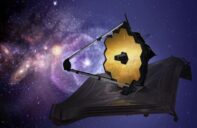 |
| Light Year | A unit of distance used in astronomy because space is so vast. It’s the distance light travels in one year, which is an incredible 9.5 trillion kilometers! It’s not a measure of time, but rather how far light can travel in a year. Image source: https://starchild.gsfc.nasa.gov/docs/StarChild/questions/question19.html |  |
| Red Dwarf Star | A small, cool star that burns much fainter than our Sun. These stars are very common in the Milky Way galaxy. Because they are cooler and redder, they wouldn’t appear very bright in the sky if one were close to our solar system. Gliese 12 is a red dwarf star. Image source: Artist’s rendition of Gliese 12 in the background: https://svs.gsfc.nasa.gov/14581/ |  |
| Transiting Exoplanet Survey Satellite (TESS) | A NASA space telescope launched in 2018. Its mission is to search for exoplanets (planets outside our solar system) by looking for them as they pass in front of their host stars, causing a temporary dip in the star’s brightness. TESS is like a giant eye in space, constantly scanning the skies for these tiny dips that reveal hidden worlds. Image source: https://www.nasa.gov/universe/nasas-tess-spacecraft-starts-science-operations |  |
| Transit | In astronomy, a transit occurs when one celestial object passes directly in front of another, as seen from our perspective. The most common example is when a planet passes in front of its star, blocking a small portion of the star’s light. This temporary dimming allows scientists to study the planet and estimate its size. Image source: Light curve of a planet transiting its star: https://science.nasa.gov/resource/light-curve-of-a-planet-transiting-its-star/ |  |
We value your input! Have questions about this issue or want to know more about our foundation?
Feel free to reach out. We’re keen to hear your thoughts and feedback. Your voice truly matters to us!
We hope you have enjoyed this issue of our newsletter.
We look forward to preparing our next issue on a different topic.
Subscribe to the Newsletter!
